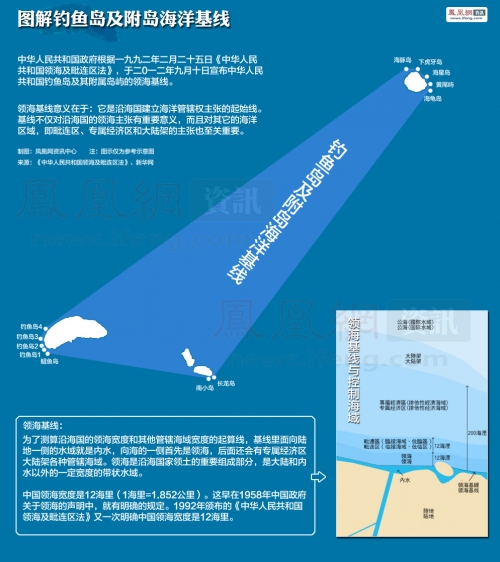BEIJING — In its heyday, the largest island was home to several hundred workers who caught fish and collected albatross feathers to adorn women's hats in Europe.
Nowadays, the only inhabitants are a hardy band of feral, inbred goats descended from a fecund pair left behind in 1978 by Japanese ultranationalists who wanted to establish a living presence on the otherwise deserted shards of land.
Rarely in geopolitics have the stakes been so large over someplace so small.

Japanese and Chinese vessels patrol near disputed islands called Senkaku in Japan and Diaoyu in China, in the East China Sea. (Kyodo News, Associated Press / September 25, 2012)
Political scientists have compared the islands so vociferously contested between China and Japan to the Falklands, which sparked the 1982 war between Argentina and Britain. But in fact they are much, much less. The Senkaku (to the Japanese) and Diaoyu (to the Chinese) consist of eight islands, the largest all of 2 miles long and the smallest a mere rock jutting out of the East China Sea. In their entirety, the islands cover less than 3 square miles.
Nevertheless, they are a tinderbox for Asia's superpowers, one in which the United States is deeply entangled. The U.S. occupied the islands after World War II and was ultimately responsible for handing back administrative authority to Japan.
Until the late 19th century, the Chinese had the strongest claim to the islands. The Chinese name, Diaoyu, (taken from a legend about a fisherman) appears in literature dating back to the 13th century. Ming Dynasty records describe the islands as navigational markers for ships traveling between China and Okinawa, which was then part of a kingdom known as Liuqiu or Ryukyu.
Chinese ships occasionally stopped at the largest island to replenish supplies of fresh water and firewood. The only documented Japanese presence is from the 16th century, when Japanese pirates used an island as a base for launching raids against the Chinese coast.
The border between China and Liuqiu was an underwater trough to the east of the islands, making them clearly part of Chinese territory, wrote Japanese scholar Unryu Suganuma, in a study published in 2000. "There was no ambiguity about the Diaoyu islands being part of Chinese territory; these eight islets belonged to the Middle Kingdom, period!" Suganuma wrote.
That sole claim changed in the late 19th century, as a rapidly modernizing Japan eclipsed China's crumbling Qing Dynasty. In the 1880s, an adventurous businessman from Fukuoka, Tatsushiro Koga, asked the Japanese government for permission to lease them.
The government initially denied his requests, saying the islands probably belonged to China ("It has been found that these islands lie near the border area with the Qing … and have Chinese names," the Japanese foreign minister wrote in an 1884 memorandum, according to Suganuma's book.) But the government changed its mind in 1895, the same year that it annexed Taiwan after its decisive victory in the first Sino-Japanese war. Japan declared the islands terra nullius, basically no man's land, and formally annexed them. The name Senkaku was a translation of "Pinnacle Islands," which British seamen had been using as a nickname for the islands because of their steep rock formations.
"The islands were part of the booty of war," said Han-yi Shaw, a scholar from Taiwan, which also lays claim to the islands.
Given a 30-year lease to the islands, the Koga family invested substantially in them. On the largest, they built houses, reservoirs and piers, and set up a collection center for albatross feathers for export to Europe as well as a processing plant for dried bonito flakes, an ingredient in Japanese fish broth. Up to 248 workers lived on the island, many of them children, as it was difficult to recruit adults to go to such a remote place.
"There was great hardship living on that island. Charter boats didn't want to stop there; food and fuel had to be imported. Koga hired children between the ages of 7 and 12 and to sweeten the deal built a school for them," said Shaw, who had been studying Japanese documents including Koga's memoir.
Koga's son, Zenji, bought four islands from the Japanese government in 1932 after the lease expired. But the business became unsustainable after Japan's entry into World War II, because of rising fuel costs and economic sanctions.
After Japan's defeat, the islands came under U.S. occupation. They were given to Japan in 1972, along with the hand-over of Okinawa.
"The United States said it wasn't taking sides in the dispute. But this was the Cold War and they didn't want the islands to fall into communist hands," said Suganuma.
Zenji Koga later sold the islands to the Kurihara family, real estate developers who did little with the property except to lease one island to the Japanese Defense Ministry for training exercises and occasional use by the U.S. military.
The current flare-up began in April when the right-wing Tokyo governor, Shintaro Ishihara, announced during a visit to the Washington-based Heritage Foundation that he was raising money to buy the islands from the Kuriharas for an estimated price of $26 million and that he would try to develop them for tourism. The Japanese government stepped in, saying it would purchase three of the islands instead. (The island leased to the military is owned by a Kurihara sister and is not included in the sale.)
There is also a private Chinese claimant to the islands: In the 1970s, the granddaughter of a prominent pharmacist produced a will and purported edict from the late Empress Dowager Cixi bequeathing the island to her grandfather, Sheng Xuanhuai. Scholars have been divided about whether the edict was genuine, but in any case, the family never developed the property. (Ironically, the heirs now operate a Chinese restaurant in Japan.)
Chinese were outraged by the proposed sale of the islands they believe are rightfully theirs. Violent protests broke out this month in dozens of Chinese cities with Japanese stores and factories attacked and Japanese-model cars overturned and set on fire. In Xian, a 51-year-old Chinese man driving his son's Toyota to do the shopping was attacked by a mob and left comatose by a beating.
Hiroyuki Kurihara, a Tokyo architect and spokesman for the Kurihara family, told the English-language Japan Times last week that the dispute should be submitted to the United Nations' International Court of Justice before any more violence takes place.
Taiwanese scholar Shaw suggests that people study the history of the islands.
"This emotional nationalism isn't going to get us anywhere. We have to win or lose on the underlying historical facts — not trash cars," Shaw said. "I don't think anybody wants to go to war over these minuscule islands."



















